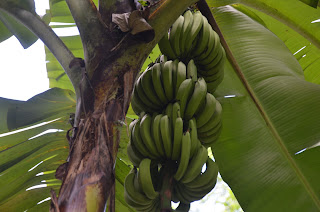As the plant matures to a height of about 10 - 15 feet it produces 1 bunch of bananas. A flower hangs down at the bottom and large "hands" of bananas form along the stem. If the hands grow too close together, the upper bananas will have dark spots on the skin, so the workers check carefully and put Styrofoam sheets between to protect the bunches and a large white plastic bag covers the whole cluster of fruit. If there are too many bananas in a bunch, the bananas will be small, so they cut off the growing end when there are approximately 260 bananas forming. Each plant produces only 1 bunch before it is cut down to about 4 feet. As the plant dies, 1 or more new plants are nourished from the dying "mother plant." The cycle of about 14 months repeats itself until the tree is about 20 years old.

 |
| Styrofoam dividers and protective bag |

When the bananas are ripe enough to ship, a worker with a large machete cuts off the whole bunch and hangs it on a chain which moves it to the processing area. There the bunches are unwrapped and individual hands are cut off and tossed into a mild soap solution. They are then cut int smaller hands, inspected and packed for shipping to the United States or Europe. Bananas that are less than prime are sold as seconds or at a local market.





















